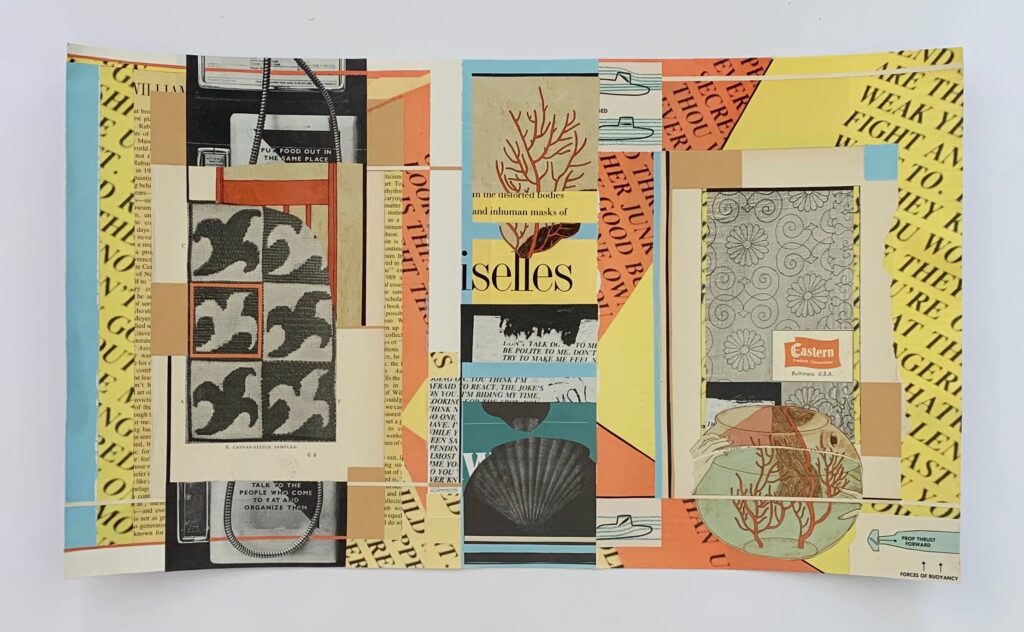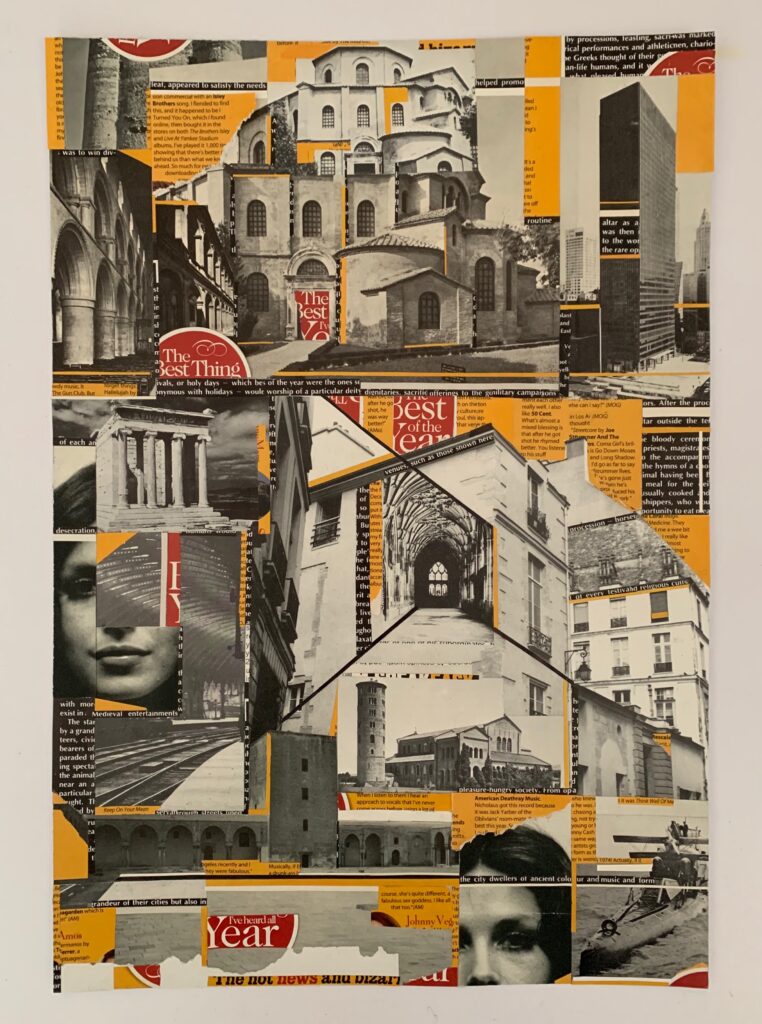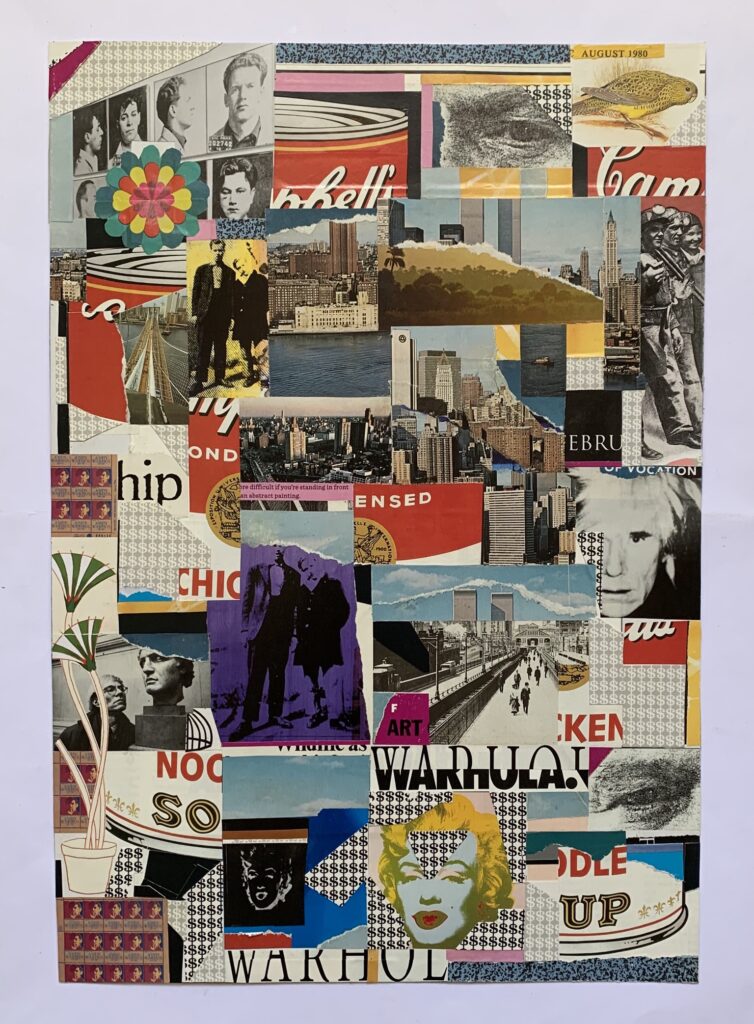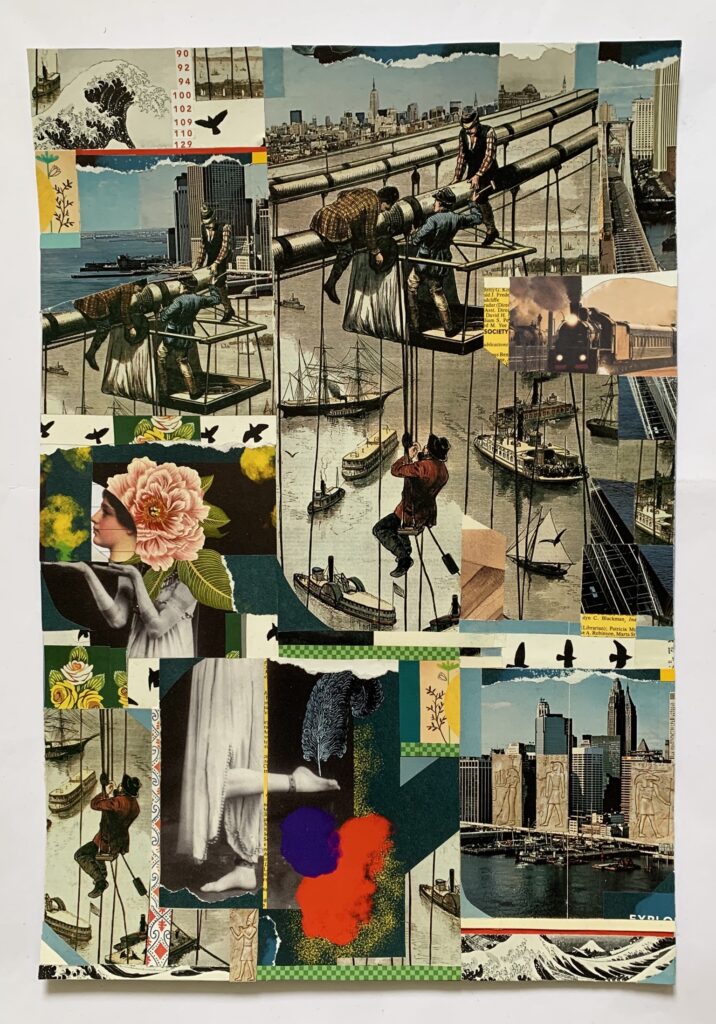Your cart is currently empty!
INTERVIEW | GORAN TOMIC
GORAN TOMIC is a Collisionist Autodidactic Artist from Sydney Australia who has exhibited his Collages, Video Installations and Performance art over the past 25 years. Raised on Rauschenberg and born posthumously he flaneur’s the urban decay searching for his Wilderness Robe.

Goran Tomic – Portrait
Instragram: @sighatticnerve | Twitter : @sighatticnerve |
____________________________________________________________________________________________________________
My Collages are a manifestation of the chaotic mayhem of modern life in a big City. The latest series of Collages were constructed when my immediate living environment changed from a wonderful old house with a large workshop to apartment block existence. With hardly any space or storage I had to downsize my work on smaller sized cardboard, manilla envelopes and various second hand children and nature book covers. The Idea was that they could fit into a folder in a carry bag/satchel and be worked on wherever I was. The Collages were started and conceived while in transit, either in cafes, pubs, libraries and even on public transport. The initial energy being my surroundings and then the finishing touches fine tuned at home.
The series I’m working on is titled “Mapping Approximation” which is a large expansive collection of Collages delving into the consciousness of the Modern Inferno that we inhabit and our oxygen giving participation to its flames. They are Compositions within compositions commenting on the current state of Technology, AI, Climate change, cheap and nasty architecture, disposable culture, medication as food, the new age Jungian world on our doorstep. This is Our Modern Inferno. You won’t find Obvious images of Blood or War or Hell in this series, the underlying theme and Through Line is my personal interpretation of Dante’s inferno.

Hand on the Holzer , 27cm x 49cm , Collage , 2024 © Goran Tomic
1.Your work has been described as “Collisionist,” reflecting urban decay and chaotic energy. Can you elaborate on what “Collisionist” means to you and how it influences your artistic process?
The overall idea or intention of “Collisionism” is to create superimpositions of stories and emotions like in Video or Film, or sampling sounds by colliding them into eachother, where you can place two or endless different scenarios against or on top or underneath like two mirrors making infinity. The possibilities are endless and beginningless. I see all the different images in one collage as different faders on a 24 or 48-track studio console. Each channel (image) has its own volume, intensity, energy, sharpness, and significance, and I play around with the faders, bringing this one to the fore or dropping that one to a backing track, a form of selective seeing or living. As a Flaneur I’m eternally influenced by observing, consuming and shaping many cultures and perceptions colliding into themselves in big city living.
2. You mention being raised on Rauschenberg’s work. How did Rauschenberg’s influence shape your approach to collage and mixed media, and how has your style evolved since then?
His Combines and Assemblages of found objects were the big killer, a real arrow to the brain. He taught me never to be afraid to blur beyond the boundaries and distinctions of mediums, to never stop exploring the investigations into finding your true self with pure expression and intellect. I recall reading how he would walk around the block and use only what he found on that brief excursion, a challenge of limitation, which I still use today. Note to self “I will only use 5 objects or images, let’s see what intriguing story or concept can be developed using just this”. My work evolves constantly due to it being about individuation, experimentation and intuition, which has led me to my own voice. There is a lot more depth in a narrative now where previously it was more about the action of creating.

I Can Fly but I’m Not Free , 30cm x 40cm , 2024 © Goran Tomic
3. “Mapping Approximation” is a powerful title for your current series. Could you share the inspiration behind this title and what it signifies in the context of your work?
In this world everything needs to be classified and interpreted and pidgeon holed, because we are afraid of the unknown, so the title came about as a result of dwelling on this. Its like we need to Map our existence to be comfortable and sane rather than living and enjoying the present state of Now. So in this series I’m trying to see things as they truly aren’t, the Way things Aren’t, and thus question what an approximation is?.
4. Your transition from a spacious house to apartment life has changed the scale and materials of your collages. How has this shift in environment influenced your artistic expression and choice of subject matter?
It seemed to be a hindrance at first but actually opened many avenues for further exploration. Initially I left a lot of open space of pure colour or actual blank spaces to compensate not having space in my physical life, open space for the mind to walk and wander through. It was minimalist which is the opposite of my usual self. It made me treasure and appreciate every centimetre I had, it was a learning process of adjustment and compromise. As I climatised physically and psychologically I used up all available space which is where I am now with the series “Mapping Approximation”. The voyage has kind of been like a longterm jet lag, which is your soul trying to catch up with the body. Your body travels and passes through other timelines and dimensions too quickly and you’re waiting for your soul to catch up, it’s disorientating and nauseating and this is represented in the collages. The subject matter has developed further inward spiritually.

The Best Thing I’ve Heard all Year , 27cm x 39cm , 2024 © Goran Tomic
5. The theme of “Our Modern Inferno” weaves through your series. Could you talk about what “Inferno” represents for you in today’s world and how you channel this concept into your art?
The themes incorporated of the lustful, the gluttonous, the hoarders and wasters are relevent now more than ever as there is so much more of it, the rejection of spiritual values for materialistic narcissictic ones. The fraud and malice against fellow humans are all concepts personified today especially in urban environments, its universal, and I can’t not be influenced by its magnitude. For me it’s a self purification exercise incorporating Dante’s themes into this series, also purification of objects and places like the city as well. It’s an extremely large endless topic.
6. Your materials are unconventional, including manila envelopes and secondhand book covers. How do these materials contribute to the narratives in your collages, and what do they add to the viewer’s experience?
Other than the size and storage factors, these materials are usually easy to carry, transport and manipulate. I like hard cover second hand books that I find or buy cheap and remove all the pages. The cover becomes the back of the artwork, and I collage on the inside so you can close it and its solid and protected. I’ve used folded menu’s also, I like how it gives it a sense of memory, time and place and what I didn’t have to eat or drink. These materials have a personalised and a forgotten world feel, which contirbutes to the story of the collage, its modern archeology and the viewer is hopefully lost in déjà vu.

Mapping Warhol © Goran Tomic
7. You mention working on your pieces in public spaces like cafes, pubs, and on public transport. How does the environment you’re in at the moment influence the pieces you create?
Firstly I work upside down like a camera obscura or early box cameras, it all makes perfect sense and everything looks better upside down. I usually work best and my happy place is when there is physical, audible and intellectual chaos moving around me. I see myself as the eye of the Hurricane where it is quiet, still and the most sane and work my way out into the madness that surrounds me, the craziness increases the further I delve outward. This has a large impact on the energy of the completed work. So when in public spaces I’m collaborating with the sounds and movements of the streets with the vibes of my immediate environment and interacting with people and technology incorporating the mayhem of information. Some of this is absorbed into the art, others used as mere stimulants. It’s also the excitement of taking risks, forcing myself to work quickly, impulsively and haphazardly to see how my thinking process deals and digests this pressure and anxiety. I can tell exactly where and what my mental state was and location at that particular moment when I look back at the collage.
8. In “Mapping Approximation,” you explore themes like technology, AI, and climate change. How do you see these issues intersecting in contemporary life, and what role do you believe art plays in addressing them?
They intersect by all being products of Capitalism and greed, the images I incorporate symbolise lost souls waiting for a new purpose, expressions of personality and behavior of Alienation. For example using images of our exploitation and failings as a society like the fast construction and profit based modern building companies. The images choose me! They choose me whether I want them to or not, signifying the present state of my understanding of the world, similar to a tarot card reading. The role I want Art to communicate is the importance of finding Individuation in this confusing over saturated existence through your passion whatever that may be, or as Jung put it “the transformation of the collective unconscious brought into consciousness by means of dreams assimilated into the whole True Self”. Art has a duty to showcase and represent its contemporary surroundings.

Hart Crane , Collage , 27cm x 38cm © Goran Tomic
9. You describe your work as “compositions within compositions.” Could you talk about the layering process in your collages and how you decide when a piece is complete?
It’s a process of Elimination and Illumination, like making a cake, layer upper layer upper layer and then removal (decollage) if necessary. I like covering images over and exposing alternate images and ideas, something I learnt from my explorations into Performance art. I like covering things so you can see that there is something under the surface, like Basquiat crossing out words makes you want to read what he has erased. I like hiding things in the textures of paper upon paper creating fantasy landscapes with altered dimensions, and if its not happening the way I feel it, I rip through the layers revealing the unknown possibilities and random combinations of colour, contours, text and any other chance like potentials. I generally know when the Collage is complete by the balance of light and dark and the balance of busy action, it’s a built in instinct.
10. Your work interprets Dante’s Inferno in a modern context, without obvious depictions of blood or hell. How do you use subtlety and abstraction to convey the themes of struggle and chaos in your collages?
I was drawn to Dante’s inferno because I see it everywhere in every day life. Being overindulged with images of war and violence and personal hellish scenes of sickness and suffering, there’s no need to present the obvious, its been done to death. What intrigues me is how each person deals or drives their way through with their corresponding level of living in hell or purgatory. For example using a Nursing Home situation as a microcosm. I like to use images that possess the inferno if you look closer or scratch the surface and make the viewer think deeper rather than give a blatant answer or statement. Images that can be interpreted as hopeful or optimistic that can go either way depending on where your head is at.People need to be told what to do and think so being subtle is my way of nudging them to investigating themselves.
